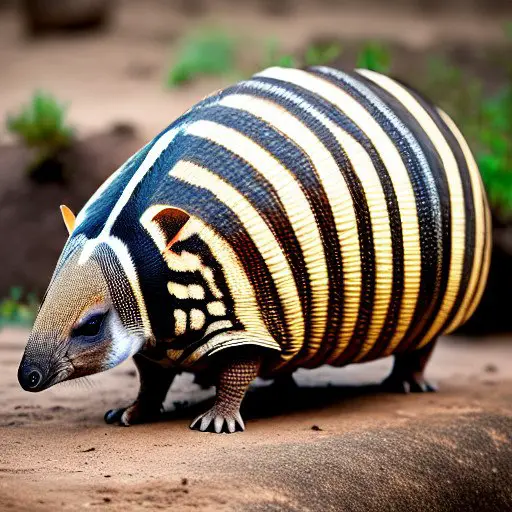TL;DR
- Only two species of armadillo, both three-banded, can roll up completely for protection.
- The La Plata three-banded armadillo can roll up but not into a complete ball.
- Other armadillo species cannot roll up due to having too many plates to curl.
- None of the armadillos actively choose to roll away from predators.
Do Armadillos Roll into a Ball? Unraveling the Myths and Facts
If you’ve ever encountered an armadillo, you may have wondered if these fascinating creatures can really roll up into a ball like the rumors say. Well, buckle up, folks, because we’re about to dive deep into the world of armadillo behavior and debunk any myths surrounding their mysterious rolling techniques.
The Three-Banded Armadillo: A True Rolling Champion
Let’s start with the poster child of the armadillo rolling phenomenon: the three-banded armadillo.
Contrary to popular belief, not all armadillos possess this unique ability, but the three-banded armadillo is indeed able to roll up completely, tucking its head and legs under its armored shell like some kind of real-life treasure chest. This nifty skill allows it to protect itself from predators who just can’t seem to crack that tough-as-nails outer layer.

Image Source: Three-Banded Wonder
The La Plata Three-Banded Armadillo: The Almost-There Roller
Next in line is the La Plata three-banded armadillo – a close relative of our champion roller but not quite as talented when it comes to getting spherical. While it can curl up for protection, it doesn’t form as perfect a ball as its superstar cousin. Think of it as your friend who claims they can do cartwheels but only manages a pretty wonky version that barely gets their feet off the ground (don’t worry, La Plata armadillos, we won’t judge you).
Why Other Armadillos Can’t Roll: A Plate Problem
Now that we’ve covered the two species capable of this astonishing feat, let’s talk about their less-flexible brethren.
Why can’t other species roll up like their three-banded counterparts?
The simple answer is they have too many plates, which prevent them from curling into that ergonomically convenient shape.
It’s much like trying to wear a suit of armor and then doing yoga; sure, you’re well protected, but your range of motion is severely limited.
No Roll-and-Away Strategy: Armadillos vs. Predators
At this point, you may be wondering if rolling-up abilities help these armadillos somehow “roll away” from their predators.
To set the record straight, let’s underline that no armadillo species in existence uses a roll-and-dash technique to escape menace.
Rolling into a ball merely serves as sturdy protection from sharp teeth and claws—think of it as pulling up a tough shield rather than fleeing the scene.
With this comprehensive look at armadillo behaviors and abilities, we hope we’ve cleared up any misconceptions and given you some fantastic fodder for your next trivia night.
So next time someone asks if all armadillos can roll into a ball, take a moment to share your newfound knowledge (and maybe even recruit some new fans for our three-banded friends).
| Species | Rolling Ability | No. of Plates | |
|---|---|---|---|
| Three-Banded Armadillo | Fully rolls into ball shape | 12-14 plates in shell
| |
| La Plata Three-Banded Armadillo
| Curls up nearly into a ball shape (close enough) | About 16plate count in shell |
|
| Quadruped-Armadillos | no-rolling | 17-19plates in-armored-shell |
“do armadillos roll” FAQs
What is the purpose of rolling up into a ball for armadillos?
The main purpose of rolling up into a ball for armadillos is to provide protection against predators. When the armadillo rolls up, it creates a tough, armored shell that makes it difficult for predators to bite or attack. This defensive mechanism helps increase their chances of survival in the wild.
Why can only three-banded armadillo species roll up completely?
The ability to roll up completely is limited to three-banded armadillo species because they have a specific number and arrangement of bony plates that allows them to curl up efficiently. Unlike other species with too many plates, which makes it impossible for them to curl, the three-banded armadillos can easily fit their heads and tails together when rolled, creating a compact and secure ball.
How do other non-rolling armadillo species protect themselves?
For non-rolling armadillo species, protection against predators usually involves relying on their natural armor, which consists of bony plates covered in keratinous skin called scutes. They may also try to escape threats by quickly digging burrows, where they can hide from predators or wedge themselves inside so that only their armor is exposed, making it difficult for potential attackers.
What are some common predators of armadillos?
Predators of armadillos include various animals such as large carnivorous mammals, birds of prey, and reptiles. Some examples are cougars, bobcats, jaguars, eagles, hawks, and large snakes like anacondas. These predators often target young or vulnerable armadillos, as breaking through the adult armadillos’ armored shell can be difficult.


